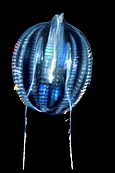
(sea gooseberry ctenophore) |
BASAL METAZOA
modified from
|
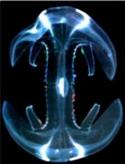
(sea butterfly ctenophore) |

(sea gooseberry ctenophore) |
BASAL METAZOA
modified from
|

(sea butterfly ctenophore) |
======================================== Porifera (sponges)
|
<<=M=====| ====P============================== Placozoa (placozoans, Trichoplax)
| |
==1==| =============================================== TO CNIDARIA ===>
==E==|
| =====C================== Ctenophora (comb-jellies)
M= METAZOA ==2===|
E= EUMETAZOA ======================== Bilateria (all higher animals)
Back to Zool 250 tree for animal phyla
TRAITS SUPPORTING EACH CLADE
(** plesiomorphic- a primitive state, not unique to clade):
|
b) diploblastic** c) outer surfaces not true epithelia (no basal lamina) c) giant compound cilia form comb rows d) colloblast cells e) pair of elongate tentacles in tentacle sheaths f) biradial symmetry g) multiciliated cells* |
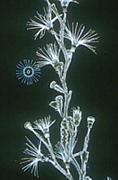
(Obelia polyps + medusa) |
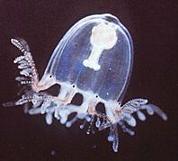
(hydrozoan medusa) |
PHYLUM CNIDARIA
(= anemones, jellyfish, etc) (tree and traits from Ruppert et al. 2004) |
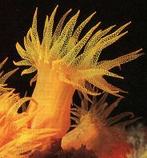
(anthozoan polyp) |
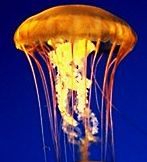
(scyphozoan medusa) |
==2============== Hydrozoa (hydroids, siphonophores, hydrocorals, etc.)
|
<<==1===| ==4========= Anthozoa$ (anemones, corals, gorgonians, etc.)
==3==|
| ===6=== Cubozoa (sea wasps)
==5==|
===7=== Scyphozoa (jellyfish)
Back to Zool 250 tree for animal phyla
TRAITS SUPPORTING EACH CLADE (** plesiomorphic- a primitive state, not unique to clade):
|
b) nematocyst with operculum c) diploblastic** and radial symmetry** b) stenotele nematocyst c) simple bell margin in medusa, no rhopalia** d) simple gastrovascular cavity in polyp** e) medusa by simple budding f) medusa has simple manubrium g) cnidocytes strictly epidermal (gastrodermis lacks cnidocytes)** h) mesoglea lacks cells i) gonads epidermal b) gastrodermal cnidocytes in both polyp & medusa stage c) gastric filaments with cnidocytes d) gastrodermal gonads e) septate gastrovascular cavity in polyp f) true myocytes migrate to mesoglea |
b) nematocysts lack operculum c) tubular pharynx with siphonoglyph in polyp b) funnel-shaped polyp c) medusae produced by strobilation d) medusa with 4 septa and septal funnels e) 8 gonadal bands on septae f) rhopalia b) small polyps lack septae c) tentacles on pedalia at corners of bell d) 4 rhopalia with complex ocelli e) velarium (velum-like structure in medusae) f) highly venomous nematocysts b) large manubrium on medusae c) 8-fold notched bell margin with rhopalia |
$Molecular data suggest Anthozoa are the sister group to the Medusozoa (=Hydrozoa + Cubozoa + Scyphozoa) and some morphological data support this relationship (Martindale et al. 2002. Molec Phylog. Evol. 24: 358).